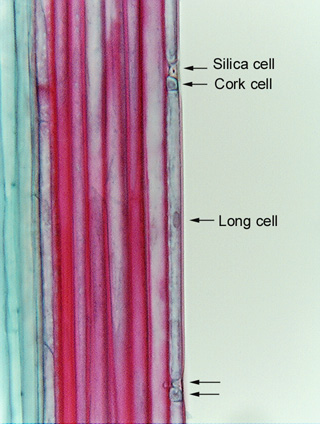 Fig.
10.5-4. Longitudinal section of corn stem (Zea mays). The epidermis
of grasses often have two types of cells: long
cells and short cells. The short cells themselves often occur in
pairs, one being a silica
cell (with a granule of silica in it), the other being a cork
cell (with suberin in its walls). These three types of cells often
have the pattern shown here: one long cell and a pair of short cells, but other
patterns occur as well. The selective advantage or ecological implications of
this type of epidermis are unknown.
Fig.
10.5-4. Longitudinal section of corn stem (Zea mays). The epidermis
of grasses often have two types of cells: long
cells and short cells. The short cells themselves often occur in
pairs, one being a silica
cell (with a granule of silica in it), the other being a cork
cell (with suberin in its walls). These three types of cells often
have the pattern shown here: one long cell and a pair of short cells, but other
patterns occur as well. The selective advantage or ecological implications of
this type of epidermis are unknown.